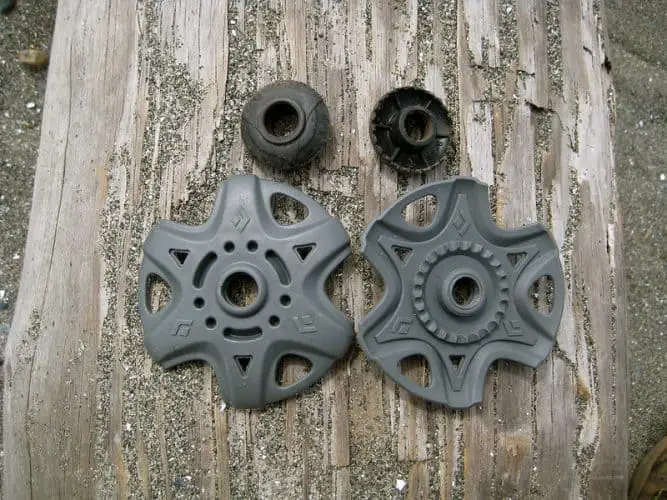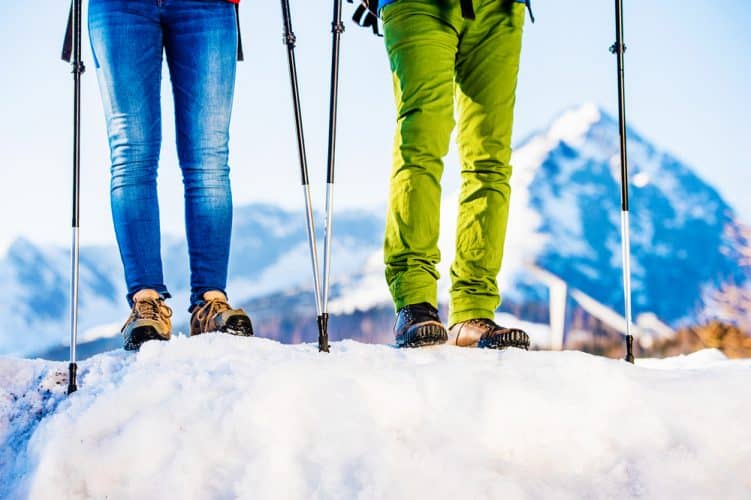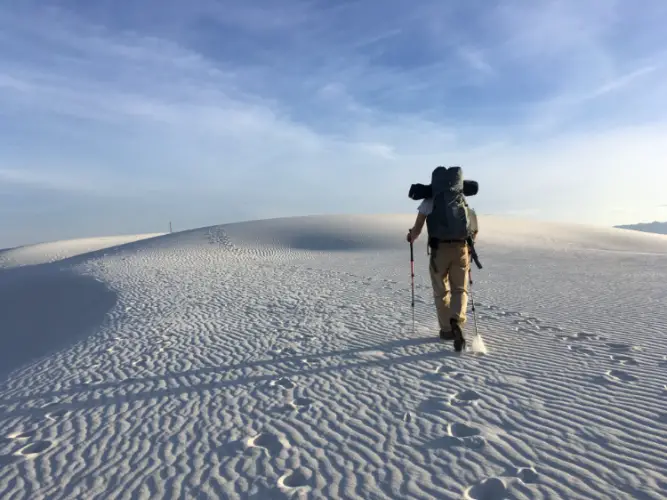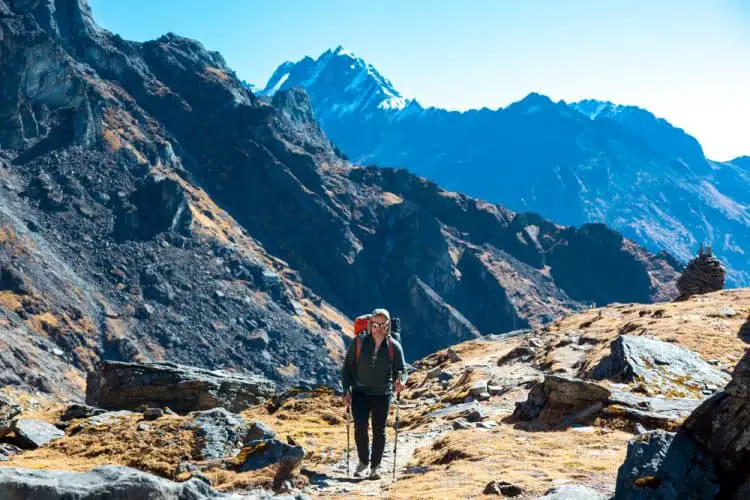What Are Trekking Pole Baskets For? (An Expert Answer)
Hiking seems like such a simple sport as it is just walking in the woods. But like any pursuit, the more you get into it, the more subtle details you discover.
What footwear is proper for you?
How to train to hike longer?
Do you need trekking poles, or are they just for older people?
The short answer to the last question is most people benefit from trekking poles. You have more stability. They spread out the fatigue by using the upper body and reduce the impact on your knees.
So you've finally chosen to use trekking poles, but now you are wondering what are trekking poles baskets for. In short, trekking poles baskets serve the purpose of keeping the tip of the poles from sinking in too deep into the ground.
This article will cover everything you need to know about using baskets with your hiking poles.
From what they are to the pros and cons, we take our experience on the trail and translate it into information you can use on your next hike.
Let's dive in.
What are trekking pole baskets for?
Trekking poles have a sharp tip to bite into dirt and ice. The baskets are small round rings (or rather disks) that keep the tip from sinking in too deep. Trekking pole baskets are like what you see on the base of a ski pole.
They increase the surface area of the base of the pole and spread out the load to the upper body. Think of them as little snowshoes for your trekking poles.
They can help keep you from sinking into snow, mud, dirt, and sand.
Do all trekking poles have baskets?
Most trekking poles will come with at least small baskets for mud. Some of them have wide baskets.
Many entry-level brands will come with multiple-sized baskets, so you have winter and 3-season use covered.
Different types of trekking pole baskets
There are three main sizes of baskets available for trekking poles depending on the softness of the surface you are hiking on.
Mud
These are the small baskets that come with most trekking poles. They are between an inch and an inch and a half in diameter.
The shape of the mud baskets is domed for stiffness, and they don't tend to have any holes in the surface to maximize support. They really help in soft ground too.
Snow
The next size up is the snow basket designed with more surface area to resist sinking into deep snow.
The diameter is about 3-4 inches, and they have cut-outs to help keep the snow from sticking. Sure enough, wearing the right snow boots in soft ground helps too.
Generally, in snow you should use wide baskets. It's a rough terrain.
Powder
Powder baskets are even bigger in diameter than snow baskets for snow that is mostly air. In dryer climates such as Utah, the snow is fluffier, which means you will sink deeper into it. It's a soft ground.
In these cases, you will also be using skis or snowshoes to navigate the terrain.
benefits of using trekking pole baskets
The main benefit of trekking pole baskets is to keep your poles from sinking too deeply into soft ground.
This increases stability, as you could fall if you lean on your pole, expecting it to support you, and it sinks deeper it the surface than you were expecting.
That's why learning how to use trekking pole baskets is a valuable skill.
Drawbacks of using trekking pole baskets
Don't want to use trekking pole baskets?
Trekking pole baskets can get caught on things like brush or between rocks. Because of the wider width of the baskets, they can get jammed in spaces that the pole itself wouldn't get stuck.
On open trails, they benefit you, but the more rugged the terrain, the more you have to pay attention to where you are placing the tips of your poles to keep the baskets from getting caught.
If the surface is soft enough that the baskets won't keep it from sinking in deeply, it can get stuck, making it harder to pull out your pole. It is your body weight pushing the tip in but only muscle power pulling it out.
When you use trekking pole baskets on a terrain where you don’t need them, you are needlessly adding extra weight.
While the added mass is small, it is located far from your core, so it gets magnified due to leverage.
While not noticeable on a short hike, the extra weight will take more energy to move, adding up on long or multi-day walks.
And if you want to reduce the weight, choose carbon fiber poles.
When you need trekking pole baskets?
Trekking pole baskets are an accessory used to match your pole to the terrain and weather They are really helpful on soft ground.
When faced with certain trail conditions, it becomes necessary to use trekking pole baskets for your poles to assist you and not inhibit your performance.
Deep Snow
Snow is a challenging terrain to walk on.
In deep snow of two feet or more, you will need to use trekking pole baskets to keep your poles from sinking. Normally skiers use their ski poles for that.
The wider snow baskets will keep your poles from sinking too deeply and will give you something to push off of, like a ski pole.
Even with baskets, your poles can sink into fresh snow pretty deep. Without baskets, you wouldn't stop until the tip of your pole hits something solid. And you need wide snow baskets. Large snow baskets are more stable on such a terrain.
This is how it works on soft ground.
Mud and Swamp
When crossing deep mud or swamp, you will find baskets a benefit. They prevent your poles from sinking into this type of soft ground.
I've hit sections when I wasn't running baskets that caused me to face plant in the mud as I leaned on my pole, and it kept on going. It taught me to use mud baskets and test the ground if it looks soft.
Low-lying areas where water pools and can't drain are home to standing mud bogs. When using your poles to move from one solid area to another while surrounded by mud and water, you don't want your trekking pole to sink, causing you to take an unexpected mud bath.
These can be of real utility during spring when the ground is saturated with water. After the snowmelt, but before everything dries out, we can face bog-like conditions.
If the soil is spongy when you walk on it rather than solid, you might be experiencing this phenomenon.
On such terrain it's also crucial to know how to use your poles correctly. Always use the wrist straps for more stability.
Sand
Nothing is more frustrating than hiking in the sand, especially uphill. The harder you go, the more you seem to stay in the same place. It's just because of the soft ground.
Trekking poles can help with this, but it helps to have baskets on your poles to increase your push and prevent the poles from sinking.
When hiking in expanses of sand, such as dunes or the desert, snow baskets can be more effective than the smaller mud versions.
Sand behaves similarly to snow, so it goes to reason that the same baskets would benefit your hike.
In sand you usually use summer baskets. Most poles come with small summer baskets. Generally those are larger baskets because larger baskets provide more stability when walking on such terrain.
If you're hiking on different terrain, you should consider getting additional baskets for extra stability in various conditions.
When you shouldn't use trekking pole baskets?
Here we go.
Rocky Terrain
With trails over broken rocky terrain, the trekking pole baskets get stuck between rocks. One of the most common causes of bent or broken poles is the basket betting stuck while the hiker keeps moving.
The long lever arm this creates exceeds the strength of the pole and leads to them getting damaged.
When you use your pole without a basket in these conditions (uneven terrain), they are much less likely to get stuck and therefore damaged.
So in such cases, you should remove trekking pole baskets.
Bushwacking
Once you venture off established trails and navigate through dense brush, you will find the baskets on your poles to be a hindrance. The baskets get caught on vines and roots, impeding your progress.
When bushwacking, trekking poles will get used in the standard way, but you will often hold them in front of your face to force vegetation apart. Thin branches tend to whip back and hit you in the face, so your poles will act to protect you from this.
If you are with people, have them follow well behind, so they aren't getting slapped in the face from the branches you displaced when you went through.
Unless you need them for deep mud when off-trail, we would advise removing trekking pole baskets to reduce the number of snags you get.
Avoid using trekking pole baskets in tall grass.
Stream Crossings
The increased surface area of the baskets that keep you from sinking into soft surfaces also increases drag in the water.
When crossing a fast-moving stream, the baskets are more likely to be caught by the current, potentially pulling you off balance.
This extra drag can make accurately placing your pole in the water a challenge. When you remove the baskets, the pole has a minimal surface area affected by the fast-moving water.
Still, your hiking poles alone will immensely help you move on such uneven terrain. And crossing a stream counts as a challenging terrain.
What to look for when buying trekking pole baskets?
When shopping for baskets for the trekking poles, you want to match them to the poles you are using and the trail conditions you expect to encounter.

Image via Pig Monkey, Flickr.
Not all baskets fit all brands of poles, so make sure they are a match before you head out on the trail.
If you expect to be faced with snow or a lot of deep sand, a broader snow basket would be in order. Otherwise, the slimmer mud baskets will do for most other conditions.
Can I use ski pole baskets on my trekking poles?
Generally, ski baskets won't fit on trekking poles. Black Diamond is an exception to this, as they have designed their ski and trekking poles to use the same thread-on attachment for their baskets.
How to remove and replace trekking pole baskets?
Almost universally, the baskets on trekking poles are threaded onto the tip of the shaft.
To remove the baskets, push them down and turn them counterclockwise. The downward push is to help them get started on the thread, as use over time tends to jam the baskets on tighter.
If you are going to put new baskets on, make sure you clean the threads, so there is no dirt or debris on them.
Don't lubricate the threads, as this can compromise the holding power and potentially have them come loose.
If you don't have baskets, then thread them on, tightening in a clockwise direction. As stated above, make sure that the surfaces are clean before you put the baskets on.
If you ever forget which way to go, remember the old saying, righty tighty, lefty loosy.
Conclusion
Like most things, trekking pole baskets have a place.
When dealing with deep snow or mud, they can help with stability. Knowing what terrain to use them on and when they are a hindrance will help make your hiking more enjoyable and reduce the risk of injury.
Winston Endall
Having worked in the outdoor, fitness, and cycling industry his whole life, Winston brings a wealth of real world knowledge on the topics. Rock climbing, backpacking, cycling and wilderness survival are his life. As both an athlete, coach, and outdoor educator, his practical experience translates into his writing to help people better pursue their outdoor passions. Read more about Winston here.







